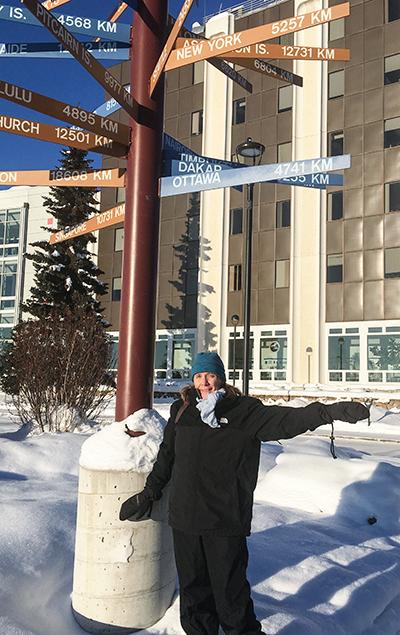Springs Teacher Heads to the Arctic

At 8:45 on Monday morning, Springs School students from kindergarten through fifth grade gathered in the gym in front of a large screen, which was connected to Skype. On the screen was Lisa Seff, their science teacher, reporting from Fairbanks, Alaska, where it was 4:45 a.m. and a bone-chilling minus 18 degrees.
“Mrs. Seff, did you see the aurora borealis?” asked a pupil.
Indeed she had — from the plane as it began its descent into Fairbanks International Airport.
“At first I thought I was looking at wisps of clouds in the sky,” Ms. Seff said. “Then suddenly, they were tinged with green and reds, and next everything erupted into a spectacular show of lights and colors around a shimmering green curtain.”
Ms. Seff is now back in Springs, where she has taught science for 17 years. Her weeklong sortie to Alaska was part of something called the PolarTREC (Teachers and Researchers Exploring and Collaborating) program, through which she will join other educators on an August expedition to the Arctic, her second such trip.
The PolarTREC program is funded by the National Science Foundation Office of Polar Regions, and Springs School is one of only 12 schools in the country to have received this grant since grants were introduced in 2007.
The school was awarded its first in 2012, when Ms. Seff joined a PolarTREC research team on an expedition to Barrow, Alaska, to study endangered bowhead whales that congregate in a feeding hot spot off the coast. Ms. Seff found the study and its results enormously valuable in helping her charges in Springs understand the ecosystem that links atmosphere, ocean, plankton, and predators.
“Since we also live in a community surrounded by water, this information is vital for students to understand and appreciate,” she said at the time. She shared her findings by posting them online, even having her detailed journals from the trip translated into Spanish so the entire community could read them.
During that 2012 expedition, Ms. Seff met Carin Ashjian, a senior scientist with the Woods Hole Oceanographic Institution in Woods Hole, Mass., whose special interest is the study of zooplankton in the polar region, which has been severely impacted by climate change. When Dr. Ashjian and her team applied once again for a PolarTREC grant — specifically, to study the food web and zooplankton in the Beaufort Sea, in the Arctic Ocean — she included Ms. Seff in her proposal.
And so, in August, the Springs teacher will trade a bathing suit for a down-filled parka and head to the Arctic once again.
“This will be a very different trip from my first one,” she said. “Whereas in 2012 we stayed on land and got on a boat each day to conduct our research, this time we’ll be living onboard a ship for four weeks.”
The ship happens to be the Sikuliaq, one of the newest and most advanced oceanographic research vessels in the world. Owned by the National Science Foundation and operated by the University of Alaska in Fairbanks, the 261-foot ship is capable of breaking ice up to 2.5 feet thick. Ice breaking will be necessary even in August, as the Sikuliaq, carrying approximately 26 researchers and 26 support crew, heads to the Beaufort Sea, where the climate is severe and the waters frozen for most of the year. Historically, only a narrow pass of approximately 61 miles has opened in August and September, but recently the ice-free area of late summer has greatly expanded.
According to the PolarTREC website, the focus of the August study is to “explore and identify the mechanisms linking broad-scale atmospheric forcing, ocean physical response, prey-base condition and distribution, upper trophic level animal aggregations, and climate change along the Beaufort Shelf break.”
In other words, explained Ms. Seff, “we’ll be studying the feeding opportunities in the region for animals such as beluga whales, seabirds, and seals.”
As a schoolteacher, she received funding from PolarTREC for equipment and training for a journaling web platform, available onboard the Sikuliaq, that will not only link students with her activities in the field but also educate them about life onboard an oceangoing vessel and about the many career possibilities available on research expeditions.
Ms. Seff believes that teaching and learning become inherently spontaneous and student-centered when moved from the confines of the classroom into the world at large.
“There is simply no comparison,” she said. “Teaching kids from the field allows a teacher to blow the walls off the classroom by connecting them directly to authentic, real-time research. It gives them an inside view, something that’s very different from what a typical textbook can convey. It makes the learning experience for the students real.”
